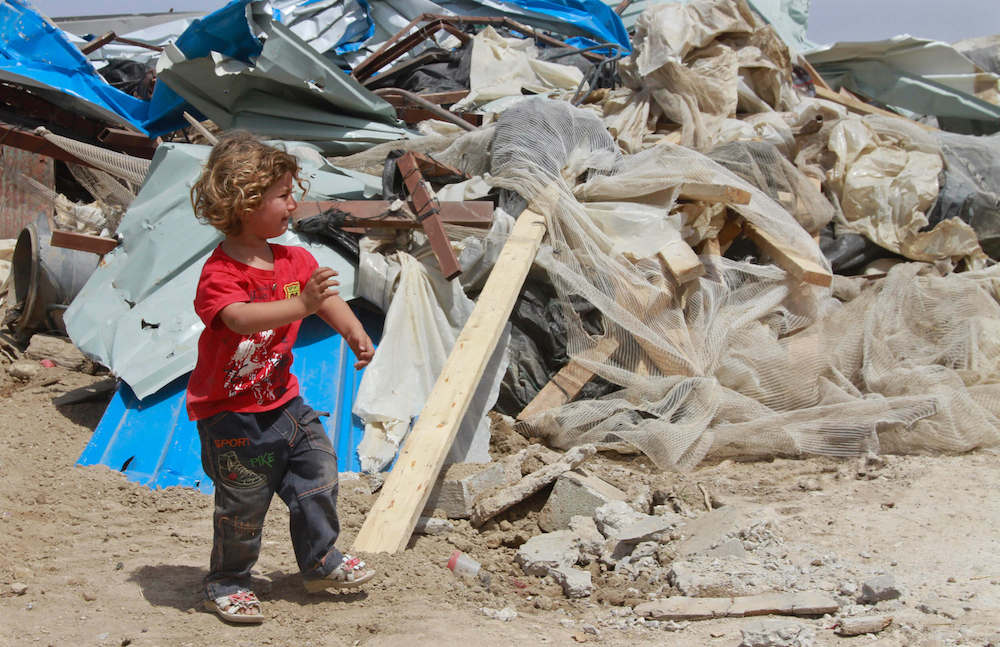Weekly Report On Israeli Human Rights Violations in the Occupied Palestinian Territory
Israeli forces continue systematic crimes in the occupied Palestinian territory (oPt)
(17 – 23 August 2017)
- Israeli forces killed a Palestinian child at Za’atarah Checkpoint, south of Nablus.
- 5 Palestinian civilians, including a child, were wounded in the West Bank and Gaza Strip.
- Israeli forces conducted 43 incursions into Palestinian communities in the West Bank and 11 others into Jerusalem and its suburbs.
- 49 civilians, including 14 children, were arrested in the West Bank.
- Twenty seven of them, including 11 children, were arrested in Jerusalem.
- Israeli forces continued to apply the collective punishment policy.
- A house was blown up in Deir Abu Mesh’al village, northeast of Ramallah.
- Israeli forces continued efforts to create Jewish majority in occupied East Jerusalem.
- A house belonging to Abu Sneinah Family was levelled for the second time within 1 week.
- Israeli forces continued settlement activities in the West Bank.
- Israeli forces confiscated rooms built of tin plates in Job al-Theeb School, east of Bethlehem.
- Israeli forces continued to target the Palestinian fishermen in the Gaza Strip Sea.
- Four shooting incidents were documented against Palestinian fishing boats in the northern Gaza Strip. Neither causalities nor arrests were reported.
- Israeli forces turned the West Bank into cantons and continued to impose the illegal closure on the Gaza Strip for the 10th
- Dozens of temporary checkpoints were established in the West Bank and others were re-established to obstruct the movement of Palestinian civilians.
- 5 Palestinian civilians were arrested at the checkpoints in the West Bank.
- Israeli forces arrested a Palestinian worker at Beit Hanoun “Erez” crossing in the northern Gaza Strip.
Summary
Israeli violations of international law and international humanitarian law in the oPt continued during the reporting period (17 – 23 August 2017).
Shooting:
During the reporting period, Israeli forces killed a Palestinian child in the West Bank and wounded 5 civilians, including a child, in the West Bank and Gaza Strip. Two of them were wounded in the West Bank, and the 3 others were wounded in the Gaza Strip. Meanwhile, Israeli forces in the Gaza Strip continued to chase the Palestinian fishermen in the sea.
In the West Bank, on 19 August 2017, Israeli forces killed Qotayabah Zahran (17) from ‘Alar village, north of Tulkarm. The abovementioned was walking near a bus station when an Israeli soldier shouted at him to stop. However, the soldier stationed inside the watchtower established at the checkpoint directly opened fire at Zahran and killed him. The Israeli forces claimed that the abovementioned child attempted to stab one of the Israeli border guard officers, who were securing the checkpoint, so he was neutralized.
In the same context, during the reporting period, Israeli forces wounded 2 Palestinian civilians after opening fire at them when the Israeli forces moved into Jenin refugee camp, north of the West Bank, to carry out an arrest campaign.
In the Gaza Strip, border areas witnessed protests against the unjust closure imposed on the Gaza population. During these protests, Israeli forces used force against the protestors, particularly when dispersing them. As a result, 3 Palestinian civilians, including a child, were wounded. One of them was wounded with a live bullet to the shoulder while the two others were wounded after being directly hit with sound bombs.
Concerning attacks on fishermen, on 21 August 2017, Israeli gunboats sporadically opened fire at and chased Palestinian fishing boats, northwest of Beit Lahia village, north of the Gaza Strip. The shooting recurred in the abovementioned area on 22 and 23 August 2017.
Incursions:
During the reporting period, Israeli forces conducted at least 43 military incursions into Palestinian communities in the West Bank, and 10 ones in Jerusalem. During these incursions, Israeli forces arrested at least 49 Palestinian civilians, including 14 children. Twenty seven of them, including 11 children, were arrested in occupied Jerusalem and its suburbs while two children were arrested during a peaceful protest in Qalqiliya.
Collective Punishment Policy:
As part of the Israeli forces’ collective punishment policy against the families of Palestinian civilians who are accused of carrying out attacks against Israeli soldiers or/and settlers. On 17 August 2017, Israeli forces blew up te first floor of a house belonging to the family of ‘Adel ‘Ankoush in Deir Abu Mesh’al, northwest of Ramallah. Asa result, the ground floor sustained severe damage as well as a nearby house. It should be mentioned that on 16 June 2017 the Israeli forces killed the above-mentioned civilian along with his two friends after a stabbing and shooting attack in occupied Jerusalem, resulting in the killing of an Israeli female soldier.
Efforts to create Jewish Majority in occupied East Jerusalem:
In the context of house demolitions, On 22 August 2017, Israeli Municipality bulldozers demolished a house belonging to ‘Abed al-Kareem Abu Sneinah in al-Bistan neighborhood in Silwan village, south of occupied Jerusalem’s Old City, for the 2nd time within one week. They then demolished the house. It should be noted that on Tuesday, 15 August 2017, the Israeli bulldozers demolished 2 houses belonging to Abu Sneinah family. Within one week, Abu Sinanh family along with activists managed to remove the rubble and re-built the house, but the Israeli forces again demolished the house. The Israeli authorities planned to demolish all the houses in al-Bostan neighborhood in favor of establishing “King Park” on its rubble.
Settlement activities and settler attacks
- In the context of house demolitions and notices, on 22 August 2017, Israeli forces moved into Kherbit Jub al-Theeb, east of Bethlehem. The Israeli forces surrounded Jub al-Theeb Primary School, which was built few days ago by GVC and funded by the European Union. The Israeli forces dismantled the school rooms built of tin plates and carried them to trucks. It should be noted that the Abovementioned School was built after al-Zawahra family donated a 5-dunum plot of land in Beit Ta’mour complex. However, the Israeli authorities notified the residents to stop the construction work in the school under the pretext of non-licensing as it is located in an area under the full Israeli control according to the Oslo Accords.
Restrictions on movement:
Israel continued to impose a tight closure of the oPt, imposing severe restrictions on the movement of Palestinian civilians in the Gaza Strip and the West Bank, including occupied East Jerusalem.
The illegal closure of the Gaza Strip, which has been steadily tightened since June 2007 has had a disastrous impact on the humanitarian and economic situation in the Gaza Strip. The Israeli authorities impose measures to undermine the freedom of trade, including the basic needs for the Gaza Strip population and the agricultural and industrial products to be exported. For 9 consecutive years, Israel has tightened the land and naval closure to isolate the Gaza Strip from the West Bank, including occupied Jerusalem, and other countries around the world. This resulted in grave violations of the economic, social and cultural rights and a deterioration of living conditions for 2 million people. The Israeli authorities have established Karm Abu Salem (Kerem Shaloum) as the sole crossing for imports and exports in order to exercise its control over the Gaza Strip’s economy. They also aim at imposing a complete ban on the Gaza Strip’s exports. The Israeli closure raised the rate of poverty to 65%. Moreover, the rate of unemployment increased up to 47% and youth constitutes 65% of the unemployed persons. Moreover, 80% of the Gaza Strip population depends on international aid to secure their minimum daily needs. These rates indicate the unprecedented economic deterioration in the Gaza Strip.
In the West Bank, Israeli forces continued to suffocate the Palestinian cities and village by imposing military checkpoints around and/or between them. This created “cantons” isolated from each other that hinders the movement of civilians. Moreover, the Palestinian civilians suffering aggravated because of the annexation wall and checkpoints erected on daily basis to catch Palestinians.
Details
- Incursions into Palestinian Areas, and Attacks on Palestinian Civilians and Property in the West Bank and the Gaza Strip
Thursday, 17 August 2017
- At approximately 01:00, Israeli forces moved into Surif village, west of Hebron. They raided and searched houses belonging to Ahmed ‘Awad al-Qadi, Fadi Mousa Mohammed Ghuneimat, ‘Ali Mohammed Mahmoud Hmedat, and Mohammed Abdul Hadi al-Hour (53) in Batn al-Hawa neighborhood. The soldiers confiscated a car belonging to al-Hour in addition to his ID card and his son’s, Nour (23), and around NIS 600. In al-Saqe’ah neighborhood, Israeli forces raided and searched a house belonging to the family of Khader Mohammed Ahmed Ghuneimat (58). They confiscated money, and the family lost jewelry. However, no arrests were reported.
Khader Ghuneimat said to PCHR’s field worker:
“At approximately 01:30, I walk up to a sound of heavy knocking on the door. When I opened the door, about 15 soldiers, a police man and female soldier entered the house. They ordered me to bring my ID card. A soldier informed me that they were looking for money belonging to Hamas Movement. My family comprised of 3 daughters was all held in a room in a room. One of my daughters is 11 years old and suffers from autism. I sat in the living room as the soldiers were searching the house and my car that was in the garage. They then moved the family to another room and physically searched them. They then searched my daughters’ rooms for half an hour and then came to the living room. They confiscated around NIS 3986 and JD 190. The confiscated money was written down in a case report, which the soldiers gave me a copy of. After we cleaned up the house, my daughter Ebaa’, whose tuition fees were confiscated, lost a gold necklace with her name on it from her room.”
- At approximately 02:00, Israeli forces moved into Balata refugee camp, east of Nablus. They raided and searched a house belonging to Mohammed Lutfi Marshoud (25) and then arrested him.
Note: During the aforementioned day, Israeli forces conducted (3) incursions in the following areas and no arrests were reported: Dura and Hadab villages and al-Fawar refugee camp in Hebron.
Friday, 18 August 2017
- At approximately 00:30, Israeli forces moved into Tubas. They raided and searched a house belonging to Radi Omer Saleh Sawaftah (24) and then arrested him.
- At approximately 01:00, Israeli forces moved into Bethlehem and stationed in al-‘Atan Street in the centre of the city. They raided and searched a house belonging to Majed Mosa Jaber (33) and then arrested him.
Note: During the aforementioned day, Israeli forces conducted (3) incursions in the following areas and no arrests were reported: Yatta and Bani Na’im village in Hebron.; and Howarah village, south of Nablus.
Saturday, 19 August 2017
- At approximately 01:00, Israeli forces moved into Beit Fajjar village, south of Bethlehem. They raided and searched a number of houses after which they handed summonses to 3 civilians to refer to the Israeli Intelligence Service in “Gush Etzion” settlement complex, south of the city. The 3 civilians were identified as Ibrahim Deriyah, Ahmed Se’dah and Ahmed Taqatqa.
- Around the same time, Israeli forces moved into Marah Rabah village, south of Bethlehem. They raided and searched a number of houses and then handed a summons to Mahmoud Mohammed ‘Amr al-Sheikh to refer to the Israeli Intelligence Service in “Gush Etzion” settlement complex, south of the city.
- At approximately 01:30, Israeli forces moved into Jenin and its refugee camp. They raided and searched a number of houses. Dozens of young men gathered and threw stones and empty bottles at the Israeli forces. The soldiers fired live and metal bullets, tear gas canisters and sound bombs at them. As a result, a 22-year-old civilian sustained live bullet wound to the right leg, and a 22-year-old civilian sustained live bullet wound to the left leg. The Israeli forces arrested 3 civilians from the camp namely Mohammed Ahmed Abu al-Haija, Mohammed ‘Ar’arawi and Kamal Mohammed ‘Awad. They also handed 2 summonses to Amin and Bahaa’ Mohammed Abu al-Haija to refer to the Israeli Intelligence Service in “Salem” military camp, south of the city.
- At approximately 17:40, Israeli forces stationed at Za’tarah checkpoint, south of Nablus, killed Quteibah Yusuf Zahran (17) from ‘Alar village, north of Tulkarm. Eyewitnesses said to PCHR’s fieldworker that Zahran was walking near a bus station around 200 meters away from the southern side of the abovementioned checkpoint. A soldier shouted at him to stop, but another soldier stationed in the military watchtower directly shot him. An hour later, the child succumbed to serious wounds he sustained. Israeli forces claimed that Zahran attempted to carry out a stab attack against Members of the Border Guard Forces, who were at Za’tarah checkpoint, so he was naturalized.
- At approximately 18:50, Israeli forces moved into Kafer Qadoum village, northeast of Qalqiliyah. They raided and searched a house belonging to Ibrahim Jamal Jom’ah (17) and then arrested him.
Sunday, 20 August 2017
- At approximately 01:00, Israeli forces moved into ‘Alar village, north of Tulkarm. They raided and searched a house belonging to Tareq Zeyad Yusuf Zahran (25) and then arrested him. It should be noted that the abovementioned civilian is brother of Qotaybah Zahran, who was killed by the Israeli forces stationed at Za’tarah checkpoint, south of Nablus in the previous day evening.
- Around the same time, Israeli forces moved into Beit Ummer village, north of Hebron. They raided and searched a house belonging to Ahmed Rashid Sabarnah and then handed him a summons for his son ‘Ali (21) to refer to the Israeli Intelligence Service in “Gush Etzion” settlement complex, south of Bethlehem. In the early morning, ‘Ali was arrested after he referred to the Israeli Intelligence Service.
- At approximately 01:30, Israeli forces moved into Bethlehem and stationed in Shaheen Valley area. They raided and searched a house belonging to Qatibah Saleh Qasem (30) and then handed him a summons to refer to the Israeli Intelligence Service in “Gush Etzion” settlement complex, south of the city.
- At approximately 02:00, Israeli forces moved into Beit Jala and stationed in al-Jadawel neighborhood. They raided and searched a house belonging to Shadi Mohammed Badawnah (25) and then handed him a summons to refer to the Israeli Intelligence Service in “Gush Etzion” settlement complex, south of the city.
- At approximately 20:50, Israeli forces moved into Kafel Hares village, north of Salfit. They patrolled the village streets under the pretext of protecting settlers visiting the religious tombs. They also announced by loud speakers that they imposed a curfew on the village. They raided and searched a house belonging to Suleiman Mohammed Abu Ya’qoub after they broke a glass door. They then arrested Suleiman’s son, Sari (20).
Note: During the aforementioned day, Israeli forces conducted (5) incursions in the following areas and no arrests were reported: Barta’ah village, southwest of Jenin; Dura, Bani Na’im al-Rayheyah villages and al-Fawar refugee camp in Hebron.
Monday, 21 August 2017
- At approximately 01:00, Israeli forces moved into Nablus. They raided and searched a house belonging to Zaid Zeyad al-Kharaz (21) in Khelet al-‘Amoud, south of the city, and then arrested him.
- Around the same time, Israeli forces moved into al-Daheyah neighborhood, southeast of Nablus. They raided and searched a house belonging to Fadel Hamed al-Betawi (33) and then arrested him.
- At approximately 01:30, Israeli forces moved into Madama village, south of Nablus. They raided and searched a number of houses and then arrested Mohammed Salah Sa’id Qet (23) and ‘Obadah Fathi Mustafa Qet (23).
- Around the same time, Israeli forces moved into Deir Abu Mash’al village, northwest of Ramallah. They raided and searched a house belonging to Ibrahim Khair Suleiman (29) and then arrested him.
- At approximately 02:00, Israeli forces moved into Bethlehem and stationed in Shaheen Valley area. They raided and searched several houses and then handed a summons to Haroun ‘Essa Qasem (31) to refer to the Israeli Intelligence Service in “Gush Etzion” settlement complex, south of the city.
- Around the same time, Israeli forces moved into Beit Ummer village, north of Hebron. They raided and searched a number of houses and then arrested Thaer Ahmed Saqer Salibi (18) and Mukhtar Sa’ed Mahmoud ‘Awad (18).
- At approximately 03:00, Israeli forces moved into al-Dheishah refugee camp, south of Bethlehem. They raided and searched a house belonging to Ja’afar Khalil ‘Obaiyat (28) and then arrested him.
- Around the same time, Israeli forces moved into al-Fawar refugee camp, south of Hebron. They raided and searched a house belonging to Walid Ahmed Teti (44) and the arrested him.
- At approximately 07:35, Israeli gunboats stationed offshore, northwest of Beit Lahia village in the northern Gaza Strip, opened fire at Palestinian fishing boats sailing within 3 nautical miles and chased them. As a result, the fishermen were forced to flee fearing for their lives, but neither casualties nor material damage were reported.
Note: During the aforementioned day, Israeli forces conducted (6) incursions in the following areas and no arrests were reported: ‘Asirah northern village, north of Nablus; Sela al-Thaher village, south of Jenin; Kafer Thuluth village, east of Qalqiliyah; Sa’ir, al-Hadab villages and al-Fawar refugee camp in Hebron.
Tuesday, 22 August 2017
- At approximately 02:00, Israeli forces moved into the southern area in Hebron. They raided and searched a house belonging to Khalid Ibrahim Abu Turki (45) and then arrested him.
- At approximately 05:45, Israeli gunboats stationed offshore, northwest of Beit Lahia village in the northern Gaza Strip, opened fire at Palestinian fishing boats sailing within 3 nautical miles. They also fired flare bombs and chased them. As a result, the fishermen were forced to flee fearing for their lives, but neither casualties nor material damage were reported.
Note: During the aforementioned day, Israeli forces conducted (4) incursions in the following areas and no arrests were reported: Qalqiliyah and ‘Azoun village, east of the city, and al-Thaheriyah and al-Majd villages in Hebron.
Wednesday, 23 August 2017
- At approximately 05:15, Israeli gunboats stationed offshore, northwest of Beit Lahia village in the northern Gaza Strip, opened fire at Palestinian fishing boats sailing within 3 nautical miles. They also fired flare bombs and chased them. As a result, the fishermen were forced to flee fearing for their lives, but neither casualties nor material damage were reported. The Israeli forces opened fire again at approximately 07:50 on the same day morning.
Demonstrations in protest against the annexation wall and settlement activities
West Bank:
- Following the Friday prayer on 18 August 2017, dozens of Palestinian civilians and Israeli and international human rights defenders organized protests in Bil’in and Ni’lin villages, west of Ramallah; al-Nabi Saleh village, northwest of the city, and Kafer Qadoum village, northeast of Qalqiliyah. Israeli forces forcibly dispersed the protesters, firing live and metal bullets, tear gas canisters and sound bombs. They also chased protesters into olive fields and between the houses. As a result, some of the protesters suffered tear gas inhalation while others sustained bruises as Israeli soldiers beat them up.
- At approximately 16:30 on the same Friday, Palestinian civilians organized a protest in the center of Qalqiliyah. They made their way to “Eyal” checkpoint established on the green line between Qalqiliya and Israel, northeast of the city. The protesters threw stones at the Israeli soldiers stationed there. The soldiers fired tear gas canisters and sound bombs at them and chased them. They arrested 2 civilians, including a child, namely Laith yusuf (16) and Ahmed ‘Adel al-Haj Hasan (22).
Gaza Strip:
- At approximately 16:00 on the same Friday, 18 August 2017, dozens of Palestinian civilians gathered near the border fence between the Gaza Strip and Israel, east of Jabalia in the northern Gaza Strip, in response to calls for protests in the border area against the Israeli measures in occupied Jerusalem. A number of the young men set fire to tires and threw stones at the Israeli forces stationed along the abovementioned border fence. The soldiers fired live bullets, tear gas canisters and rubber-coated metal bullets at them. The clashes continued until approximately 20:00 on the same day. As a result, a 20-year-old civilian, from al-Tuffah neighborhood, sustained a live bullet wound to the left shoulder; a 24-year-old civilian from Sheikh Redwan neighborhood in Gaza was hit with a tear gas canister to the back; and a 16-year-old civilian, from Jabalia, was hit with a tear gas canister to the chest.
(PCHR keeps the name of the wounded civilians)
Collective Punishment:
- As part of the collective punishment policy adopted by the Israeli forces against the Palestinian civilians accused of carrying out attacks against Israeli soldiers or/and settlers, on Thursday dawn, 17 August 2017, Israeli forces demolished a house belonging to ‘Adel Hasan Ahmed ‘Ankoush in Deir Abu Mesh’al village, northwest of Ramallah. ‘Ankoush was killed by the Israeli forces on 16 June 2017.
According to PCHR’s investigation and eyewitnesses’ accounts, at approximately 02:00 on Thursday, 17 August 2017, Israeli forces backed by several military jeeps and an engineering unit moved into Deir Abu Mesh’al village, northwest of Ramallah. They then surrounded a 2-storey house belonging to the family of ‘Adel Hasan Ahmed ‘Ankoush. The house was built on an area of 150 square meters, sheltering 6 members, including 4 children. Many soldiers raided the second floor in the house while the engineering unit planted explosives inside and blew it up. As a result, the ground floor sustained serious damage in addition to a nearby house belonging to Mustafa Sobhi Far as the bedroom wall collapsed.
It should be noted that on 16 June 2017, the Israeli forces killed ‘Adel and two of his friends namely Bara’a Ibrahim Saleh ‘Ata and Osama Ahmed Dahdouh ‘Ata from Deir Abu Mesh’al village, after they carried out a stab and shooting attack against al-Sultan Suleiman Street at the northern entrance to Bab al-Amoud (Damascus Gate) in East Jerusalem. The attack caused the death of an Israeli female soldier. Moreover, the Israeli forces raided the houses of the 3 killed civilians on 17 June 2017 and orally informed them of the demolition decision of their houses after they took thir measurements.
- Continued closure of the oPt
Israel continued to impose a tight closure on the oPt, imposing severe restrictions on the movement of Palestinian civilians in the Gaza Strip and the West Bank, including occupied East Jerusalem.
Gaza Strip
Israeli forces continuously tighten the closure of the Gaza Strip and close all commercial crossings, making the Karm Abu Salem crossing the sole commercial crossing of the Gaza Strip, although it is not suitable for commercial purposes in terms of its operational capacity and distance from markets.
Israeli forces have continued to apply the policy, which is aimed to tighten the closure on all commercial crossings, by imposing total control over the flow of imports and exports.
Israeli forces have continued to impose a total ban on the delivery of raw materials to the Gaza Strip, except for very limited items and quantities. The limited quantities of raw materials allowed into Gaza do not meet the minimal needs of the civilian population of the Gaza Strip.
Israeli forces also continued to impose an almost total ban on the Gaza Strip exports, including agricultural and industrial products, except for light-weighted products such as flowers, strawberries, and spices. However, they lately allowed the exportation of some vegetables such as cucumber and tomatoes, furniture and fish.
Israel has continued to close the Beit Hanoun (Erez) crossing for the majority of Palestinian citizens from the Gaza Strip. Israel only allows the movement of a limited number of groups, with many hours of waiting in the majority of cases. Israel has continued to adopt a policy aimed at reducing the number of Palestinian patients allowed to move via the Beit Hanoun crossing to receive medical treatment in hospitals in Israel or in the West Bank and East Jerusalem. Israel also continued applying the policy of making certain civilian traveling via the crossing interviewed by the Israeli intelligence service to be questioned, blackmailed or arrested.
Movement at Karm Abu Salem (Kerem Shalom) crossing, southeast of Rafah, is designated for the movement of goods
Movement at Karm Abu Salem (Kerem Shalom) crossing, southeast of Rafah, is designated for the movement of goods
| Date |
Imports |
| Category |
Amount |
| Tons |
Number |
Liters |
| 07 August |
Various goods |
3526 |
|
|
| Humanitarian aid |
16034 |
|
|
| Cooking gas |
292,410 |
|
|
| Benzene |
|
|
190,039 |
| DieselDiesel for UNRWA |
|
|
189,97938,000 |
| Construction aggregates |
11320 |
|
|
| Cement |
2680 |
|
|
| Construction steel |
228 |
|
|
| 08 August
|
Various goods |
3484 |
|
|
| Humanitarian aid |
15800 |
|
|
| Cooking gas |
296,210 |
|
|
| Benzene |
|
|
114,023 |
| DieselDiesel for UNRWA |
|
|
151,93276,000 |
| Construction aggregates |
11760 |
|
|
| Cement |
2960 |
|
|
| Construction steel |
413 |
|
|
| 09 August |
Various goods |
3155 |
|
|
| Humanitarian aid |
1516 |
|
|
| Cooking gas |
298,630 |
|
|
| Benzene |
|
|
75,986 |
| DieselDiesel for UNRWA |
|
|
189,95838.474 |
| Construction aggregates |
11120 |
|
|
|
Cement |
3080 |
|
|
|
Construction steel |
530 |
|
|
|
Various goods |
4397 |
|
|
| Humanitarian aid |
13101 |
|
|
|
Cooking gas |
292,820 |
|
|
|
Benzene |
|
|
38,002 |
|
Diesel for UNRWA |
|
|
74,650 |
| 10 August |
Construction aggregates |
8760 |
|
|
|
Cement |
3040 |
|
|
|
Construction steel |
712 |
|
|
|
Various goods |
3712 |
|
|
| Humanitarian aid |
15681 |
|
|
|
Cooking gas |
294,590 |
|
|
|
Benzene |
|
|
151,990 |
|
DieselDiesel for UNRWA
|
|
|
1,021,90639,335 |
| 13 August |
Construction aggregates |
12360 |
|
|
|
Cement |
2360 |
|
|
|
Construction steel |
487 |
|
|
|
Various goods |
4638 |
|
|
| Humanitarian aid |
15497 |
|
|
| 14 August |
Cooking gas |
297,400 |
|
|
|
Benzene |
|
|
192,072 |
|
Diesel |
|
|
1,165,927 |
|
Construction aggregates |
10600 |
|
|
|
Cement |
2780 |
|
|
|
Construction steel |
555 |
|
|
|
Various goods |
3589 |
|
|
| Humanitarian aid |
14200 |
|
|
| Cooking gas |
293,030 |
|
|
| Benzene |
|
|
78,018 |
| DieselDiesel for UNRWA |
|
|
903,21575,991
|
| 15 August |
Construction aggregates |
9800 |
|
|
|
Cement |
3240 |
|
|
|
Construction steel |
582 |
|
|
|
16 August |
Various goods |
3918 |
|
|
| Humanitarian aid |
14730 |
|
|
| Cooking gas |
289,718 |
|
|
| BenzeneBenzene for UNRWA |
|
|
152,06338,000 |
| DieselDiesel for UNRWA |
|
|
851,99538,000 |
| Construction aggregates |
11280 |
|
|
|
Cement |
1800 |
|
|
|
Construction steel |
816 |
|
|
|
Various goods |
4519 |
|
|
| 17August |
Humanitarian aid |
14813 |
|
|
|
Cooking gas |
295,664 |
|
|
|
Benzene |
|
|
302,123 |
|
DieselDiesel for UNRWA |
|
|
859,96375,992 |
| Construction aggregates |
10920 |
|
|
|
Cement |
2960 |
|
|
|
Construction steel |
863 |
|
|
|
Various goods |
3901 |
|
|
| 20 August |
Humanitarian aid |
16306 |
|
|
|
Cooking gas |
297,740 |
|
|
|
Benzene |
|
|
152,010 |
|
DieselDiesel for UNRWA |
|
|
674,84738,000 |
|
Construction aggregates |
13240 |
|
|
|
Cement |
2040 |
|
|
|
Construction steel |
580 |
|
|
|
Various goods |
3944 |
|
|
| 21 August |
Humanitarian aid |
17625 |
|
|
|
Cooking gas |
288,580 |
|
|
|
Benzene |
|
|
156,026 |
|
DieselDiesel for UNRWA |
|
|
1,022,76376,015 |
|
Construction aggregates |
13040 |
|
|
|
Cement |
3160 |
|
|
|
Construction steel |
712 |
|
|
Exports:
On Monday, 07 August 2017, Israeli forces allowed the exportation of a truckload of vegetable.
On Wednesday, 09 August 2017, Israeli forces allowed the exportation of 2 truckloads of vegetables, 2 truckloads of fish and a truckload of clothes.
On Thursday, 10 August 2017, Israeli forces allowed the exportation of a truckload of vegetables.
On Sunday, 13 August 2017, Israeli forces allowed the exportation of 0.64 tons cucumbers; 0.6 tons of fish; 14 tons of eggplants; 13.3 tons of sweet potatoes; and 0.8 tons of sweet peppers.
On Monday, 14 August 2017, Israeli forces allowed the exportation of 4.48 tons of tomatoes; 3.6 tons of eggplants; and 0.75 tons of fish.
On Wednesday, 16 August 2017, Israeli forces allowed the exportation of 10.2 tons of tomatoes; 0.6 tons of fish; 14.5 tons of sweet potatoes; 1.4 tons of peppers; and 0.8 tons of eggplants.
On Thursday, 17 August 2017, Israeli forces allowed the exportation of 6 tons of tomatoes; 13 tons of furniture and 6 tons of clothes.
On Sunday, 20 August 2017, Israeli forces allowed the exportation of 4 truckloads of vegetables and a truckload of animals’ skin.
On Monday, 21 August 2017, Israeli forces allowed the exportation of 3 truckloads of vegetables; 3 truckloads of Aluminum scrap and a truckload of tomatoes.
Beit Hanoun (“Erez”) crossing, in the north of the Gaza Strip, is designated for the movement of individuals, and links the Gaza Strip with the West Bank.
Movement at Beit Hanoun (“Erez”) crossing
(15-21 August 2017)
| Category |
15 August |
16 August |
17 August |
18 August |
19 August |
20August |
21August |
| Patients |
44 |
37 |
37 |
1 |
– |
71 |
52 |
| Companions |
37 |
36 |
33 |
1 |
– |
62 |
49 |
| Personal needs |
32 |
50 |
37 |
5 |
– |
143 |
45 |
| Familiesof prisoners |
– |
– |
– |
– |
– |
– |
31 |
| Arabs fromIsrael |
5 |
7 |
8 |
8 |
– |
8 |
1 |
| Diplomats |
– |
– |
– |
– |
– |
– |
– |
| International journalists |
– |
– |
– |
– |
– |
– |
– |
| International workers |
35 |
39 |
32 |
8 |
– |
1 |
12 |
| Travelersabroad |
65 |
– |
– |
– |
– |
6 |
– |
| Business people |
121 |
127 |
106 |
3 |
– |
199 |
126 |
| Business meetings |
– |
– |
– |
– |
– |
– |
– |
| Security interviews |
4 |
4 |
5 |
– |
– |
– |
6 |
| VIPs |
1 |
– |
– |
– |
– |
– |
2 |
| Ambulances to Israel |
5 |
5 |
2 |
1 |
– |
4 |
2 |
| Patients’ Companions |
4 |
5 |
2 |
1 |
– |
4 |
2 |
Israeli Forces Arrest Palestinian Worker at Beit Hanoun “ Erez” Crossing
- At approximately 10:00 on Tuesday, 22 August 2017, Israeli forces stationed at Beit Hanoun (Erez) crossing, northwest of Beit Hanoun, north of the Gaza Strip, arrested Ayman Rafiq Abdul Razek Hamad (43), from Beit Hanoun. Ayman has been working at the crossing for more than 20 years and is married with ten children. Ayman’s son, Isma’il, said that the Palestinian Liaison Office of the General Authority for Civil Affairs officially informed them at approximately 16:30 on the same day that his father is under arrest, without identifying the reasons. It should be noted that Ayman’s job at Erez Crossing is to carry travelers’ luggage from the Palestinian side to the Israeli’s.
Israel has imposed a tightened closure on the West Bank. During the reporting period, Israeli forces imposed additional restrictions on the movement of Palestinian civilians:
- Hebron: Israeli forces established (19) checkpoints all over the city.
On Thursday, 17 August 2017, Israeli forces established 3 checkpoints at the entrances to Sa’ir, Bait Ummer and Sureef villages.
On Friday, 18 August 2017, Israeli forces established 3 checkpoints at the entrances to Ethna village, Kharsa road and at the entrance to al-Fawar refugee camp.
On Saturday, 19 August 2017, 3 similar checkpoints were established on Beit ‘Awaa- Wad Risha road; at the entrance to Tarama village and on al-Nabi Yunis road, east of Halhoul village.
On Sunday, 20 August 2017, Israeli forces established 2 checkpoints at the northern entrance to Yatta village and at the entrance to Sa’ir village.
On Monday, 21 August 2017, 4 similar checkpoints were established at the entrance to al-Fahs road, at the entrance to Beit Kahel, at the western entrance to Hebron and on Khelit al-Maiyyah road, east of Yatta.
On Tuesday, 22 August 2017, Israeli forces established 4 checkpoints at the entrances to Beit Ummer, Ethna, Beit ‘Awaa and al-Moreq villages.
Qalqiliyia: Israeli forces established (12) checkpoints all over the city.
At approximately 12:15 on Thursday, 17 August 2017, Israeli forces established a checkpoint between ‘Azoun and ‘Izbit al-Tabeeb villages, east of Qalqilayia.
At approximately 17:00, a similar checkpoint was established at the entrance to ‘Azoun village, east of the city.
At approximately 08:00 on Friday, 18 August 2017, Israeli forces established a checkpoint under the bridge of ‘Azoun village, east of Qalqilyia.
On Saturday, 19 August 2017, Israeli forces established 5 checkpoints at the entrance to Kafur Qaddoum village, northeast of Qalqiliyia (established twice); at the entrance to ‘Azoun village ( was established twice) and at the entrance to ‘Izbit al-Tabeeb village, east of the city.
On Monday, 21 August 2017, Israeli forces established 4 checkpoints at the eastern entrance to Qalqilyia (established twice), at the entrance to Hiblah village, and at the entrance to Jeet village, northeast of the city.
Salfit: Israeli forces established (6) checkpoints all over the city.
At approximately 14:00 on Thursday, 17 August 2017, Israeli forces established a checkpoint under the bridge of Askaka village, east of Salfit.
At approximately 20:50 on Friday, 18 August 2017, Israeli forces established a checkpoint between Kaful Hares and Hares village, north of Salfit.
At approximately 22:30, a similar checkpoint was established under the bridge of Askaka village, east of the city.
At approximately 11:30 on Saturday, 19 August 2017, Israeli forces established a checkpoint under the bridge of Askaka village, east of Salfit.
At approximately 19:40, Israeli forces established a checkpoint at the northern entrance to Salfit.
At approximately 21:00 on Monday, 21 August 2017, Israeli forces established 2 checkpoints at the entrances to Deir Balout and al-Zawiyia villages, west of Salfit.
Jenin:
On Friday, 18 August 2017, Israeli forces established 3 checkpoints throughout the city. The first checkpoint was established near al-Hadad village, east of Jenin; the second one was established on Jenin-Nablus street; the third one was established in the vicinity of Ya’boud and ‘Orabah villages, southwest of the city.
Arrests at Military Checkpoints:
- At approximately 18:00 on Friday, 18 August 2017, Israeli forces stationed at a military checkpoint in Hebron, arrested Anas Ibrahim Mohamed Qat (21), from Madamah village, south of Nablus. Anas was on a trip with his family to Hebron. In the meantime, the Israeli forces stopped the family, checked their IDs and then arrested Anas.
- At approximately 07:30 on Monday, 21 August 2017, Israeli forces established a checkpoint at the intersection of al-Nabi Salah village, northwest of Ramallah. They stopped Palestinian vehicles and checked civilians’ IDs. In the meantime, they arrested Mohamed Faied ‘Arqoub (18), from Kafur ‘Ain village, northwest of the city.
- On Wednesday, 24 August 2017, Israeli forces, who were patrolling in the vicinity of Daniel settlement, south of al-Khadir village, south of Bethlehem, arrested 3 Palestinian civilians while they were at the southern entrance to the village. The arrested persons were identified as Reziq Shehadah Salah (44), Ashraf Mahmoud Salah (39), and Museed Suliman Salah (37).
Efforts to Create Jewish majority
Israeli forces escalated their attacks on Palestinian civilians and their property. They have also continued their raids on al-Aqsa Mosque and denied the Palestinians access to it:
- At 01:00 on Thursday, 17 August 2017, Israeli forces moved into Silwan village, south of occupied East Jerusalem’s Old City. They raided and searched houses from which they arrested Mohamed ‘Arafat Abu al-Hamam (19), ‘Odai Samer Abu Tayieh (19), and Abed al-Raheem al-‘Abasi (33).
- At approximately 02:00 on Friday, 18 August 2017, Israeli forces moved into Silwan village, south of occupied East Jerusalem’s Old City. They raided and searched a house belonging to Mohamed Mansour al-‘Abasi (17) and arrested him.
- At approximately 10:00 on Saturday, 19 August 2017, Israeli forces moved into Silwan village, south of occupied East Jerusalem’s Old City. They raided and searched a house belonging to Mohamed Hisham al-Qaq (22) and handed him a summons to refer to the Israeli Intelligence Service in al-Nabi Ya’qoub police station, north of the city.
- At approximately 01:00 on Sunday, 20 August 2017, Israeli forces moved into al-‘Issawiyia village, northeast of occupied East Jerusalem. They raided and searched houses from which they arrested Mohamed Monther ‘Atiyiah (15), Mohamed Thaier Mahmoud (16) and Mahmoud Adeib Abu al-Humus (14).
- At approximately 02:30, Israeli forces moved into Hizmah village, northeast of occupied Jerusalem. They raided and searched houses from which they arrested Mohamed Fawzi al-Khatib (20), Abdullah Abed Rabu al-Khatib (21), ‘Ahed Salem ‘Askar (19), Ahmed Waheed al-Khatib(21), and Abdullah Ahmed al-Khatib(20).
- At approximately 13:00 on Sunday, Israeli forces handed al-Sheikh Nour al-Deen Ishaq al-Rajbi (54) a summons to refer to the Israeli Intelligence Service in al-Maskobiyia police center in West Jerusalem, in order to question him. At approximately 08:00 on Monday, 21 August 2017, the Israeli forces arrested al-Rajabi when he attended al-Mascoubiyia center and questioned him. At approximately 22:00 on the same day, Nour al-Deen was released, but he was forcibly deported from al-‘Aqsa Mosque for one week. This summons handed to al-Sheikh al-Rajabi is the 3rd summons within one month. It should be noted that the Israeli forces previously arrested al Rajabi and beat him up in the vicinity of al-Asbat (Lion Gate).
- At approximately 00:00 on Monday, 21 August 2017, Israeli forces moved into Ras al-‘Amoud neighborhood, east of occupied East Jerusalem’s Old City. They raided and searched a house belonging to Abdullah Jamal Ma’arjah (17) and arrested him.
- At approximately 01:00 on Monday, Israeli forces moved into al-‘Izariyia village, east of occupied Jerusalem. They raided and searched a house belonging to Hasan Ashraf Abu al-Reesh (17) and arrested him.
- At approximately 02:00, Israeli forces moved into al-‘Issawiyia village, northeast of occupied Jerusalem. They raided and searched houses from which they arrested 4 Palestinian civilians, including 3 children. The arrested persons were identified as Mahmoud Adib Abu Humus (14), Mohamed Monther ‘Atiyiah (15), Mohamed Thaier Suliman (16) and Ali Hasan Muhasin (19).
- At approximately 02:30, Israeli forces moved into Badow village, northwest of occupied Jerusalem. They raided and searched houses from which they arrested Adham Mohamed Saleh Badwan and Saleh Kassab ‘Ayyash.
- At approximately 16:00 on Tuesday, 22 August 2017, Israeli forces raided and searched a house belonging to Mohamed Fahmi Faroukh in ‘Ain al-Louza neighborhood in Silwan village, south of occupied Jerusalem. They also arrested Mohamed’s daughter, Heba (15), and took her to an unknown destination. Fahmi Faroukh, Mohamed’s father, said that the Israeli forces accompanied with Israeli Intelligence officers and sniffer dogs raided his son’s house and prevented anyone from entering it. In the meantime, they beat up all the house residents. As a result, Mohamed’s wife sustained a toe fracture and was then taken to receive medical treatment. Moreover, the Israeli forces attacked Fahim’s grandchild, Yazan (14). Fahmi added that the Israeli forces damaged all the house contents and arrested his son, Mohamed, his grandchild, Heba, without showing either the search or arrest warrant.
- At approximately 01:30 on Wednesday, 23 August 2017, Israeli forces moved into Badow village, northwest of occupied Jerusalem. They raided and searched houses from which they arrested Yousef Khalid Dar al-Shaiekh, Ahmed Husain al-Shaiekh, Mohamed Falah al-Shaiekh and Abdullah Kamal al-Shaiekh.
- On Tuesday, 22 August 2017, Israeli Municipality bulldozers demolished a house belonging to ‘Abed al-Kareem Abu Sneinah in al-Bostan neighborhood in Silwan village, south of occupied Jerusalem’s Old City, for the 2nd time within one week. Silwan village’s residents said that the Israeli forces accompanied with Israeli vehicles and Israeli Municipality crews moved into al-Bostan neighborhood, surrounded the under-construction house of Abu Sneinah family, and demolished it.
It should be noted that, on Tuesday, 15 August 2017, the Israeli bulldozers demolished 2 houses belonging to Abu Sneinah family. During one week, Abu Sinanh family along with activists removed the rubble and re-built the house, but the Israeli forces demolished the house again. The Israeli authorities planned to demolish all houses in al-Bostan neighborhood in favor of establishing “King Park” as since 2005, the Israeli authorities have distributed notices to residents. Over the past period, the residents were able to delay and abolish demolition orders through popular campaigns and legal proceedings. All the decisions are in effect now after the Israeli the municipality rejected all the plans submitted by the residents.
- Israeli settlers’ attacks against Palestinian civilians and property
- At approximately 19:00 on Tuesday, 22 August 2017, Israeli forces accompanied with around 30 military vehicles and mounted-crane trucks moved into Kherbit Jub al-Deeb, east of Bethelehm, which is located in Beit Ta’mour residential complex. The Israeli forces surrounded Jub al-Deeb Primary School, which was built of tin plates few days ago by GVC and funded the EU. The Israeli forces dismantled the tin plates and carried them to the truck. The Israeli forces stationed in the area until 00:00, during which, the village residents attempted to prevent the Israeli forces from stationing in the area. As a result, the Israeli forces fired sound bombs and tear gas canisters at the residents and then detained them in a far place until the military vehicles withdrew.
It should be noted that the Abovementioned School was built after Zawahra family donated a five-and-a-half-dunum plot of land in the centre of the Beit Ta’mour complex. The school administration was informed by the Israeli authorities to stop construction work in the school under the pretext of non-licensing. However, the project was completed, and six out of eight caravans were placed one day before the beginning of the new school year. Khirbet Jub al-Deeb is located in an area under the full Israeli control, so its residents should obtain permits from the Israeli Civil Administration to enable them to build and use the land for any purpose. This is considered impossible because of the impossible conditions imposed by the Israeli authorities in this regard, not to mention the Israeli Civil Administration’s policy of deliberately neglecting planning and developing the Palestinian villages located within the ‘C’ areas such as Jub al-Deeb to force its residents to leave voluntarily and move from their lands and villages to other areas. In the past years, the Israeli authorities have tightened their grip on the village residents to force them to leave, targeting three houses belonging to the residents under the pretext of non-licensing. Moreover, five other families left the village because they were deprived of their rights in the village and forced them to live in other areas. The rest of the village’s houses are still under threat because of non- licensing.
Recommendations to the International Community
PCHR warns of the escalating settlement construction in the West Bank, the attempts to legitimize settlement outposts established on Palestinian lands in the West Bank and the continued summary executions of Palestinian civilians under the pretext that they pose a security threat to the Israeli forces. PCHR reminds the international community that thousands of Palestinian civilians have been rendered homeless and lived in caravans under tragic circumstances due to the latest Israeli offensive on the Gaza Strip that has been under a tight closure for almost 10 years. PCHR welcomes the UN Security Council’s Resolution No. 2334, which states that settlements are a blatant violation of the Geneva Conventions and calls upon Israel to stop them and not to recognize any demographic change in the oPt since 1967. PCHR hopes this resolution will pave the way for eliminating the settlement crime and bring to justice those responsible for it. PCHR further reiterates that the Gaza Strip and the West Bank, including East Jerusalem, are still under Israeli occupation in spite of Israel’s unilateral disengagement plan of 2005. PCHR emphasizes that there is international recognition of Israel’s obligation to respect international human rights instruments and international humanitarian law. Israel is bound to apply international human rights law and the law of war, sometimes reciprocally and other times in parallel, in a way that achieves the best protection for civilians and remedy for the victims.
- PCHR calls upon the international community to respect the Security Council’s Resolution No. 2334 and to ensure that Israel respects it as well, in particular point 5 which obliges Israel not to deal with settlements as if they were part of Israel.
- PCHR calls upon the ICC in 2017 to open an investigation into Israeli crimes committed in the oPt, particularly the settlement crimes and the 2014 offensive on the Gaza Strip.
- PCHR Calls upon the European Union (EU) and all international bodies to boycott settlements and ban working and investing in them in application of their obligations according to international human rights law and international humanitarian law considering settlements as a war crime.
- PCHR calls upon the international community to use all available means to allow the Palestinian people to enjoy their right to self-determination through the establishment of the Palestinian State, which was recognized by the UN General Assembly with a vast majority, using all international legal mechanisms, including sanctions to end the occupation of the State of Palestine.
- PCHR calls upon the international community and United Nations to take all necessary measures to stop Israeli policies aimed at creating a Jewish demographic majority in Jerusalem and at voiding Palestine from its original inhabitants through deportations and house demolitions as a collective punishment, which violates international humanitarian law, amounting to a crime against humanity.
- PCHR calls upon the international community to condemn summary executions carried out by Israeli forces against Palestinians and to pressurize Israel to stop them.
- PCHR calls upon the States Parties to the Rome Statute of the ICC to work hard to hold Israeli war criminals accountable.
- PCHR calls upon the High Contracting Parties to the Geneva Conventions to fulfill their obligations under article (1) of the Convention to ensure respect for the Conventions under all circumstances, and under articles (146) and (147) to search for and prosecute those responsible for committing grave breaches of the Geneva Conventions to ensure justice and remedy for Palestinian victims, especially in light of the almost complete denial of justice for them before the Israeli judiciary.
- PCHR calls upon the international community to speed up the reconstruction process necessary because of the destruction inflicted by the Israeli offensive on Gaza.
- PCHR calls for a prompt intervention to compel the Israeli authorities to lift the closure that obstructs the freedom of movement of goods and 1.8 million civilians that experience unprecedented economic, social, political and cultural hardships due to collective punishment policies and retaliatory action against civilians.
- PCHR calls upon the European Union to apply human rights standards embedded in the EU-Israel Association Agreement and to respect its obligations under the European Convention on Human Rights when dealing with Israel.
- PCHR calls upon the international community, especially states that import Israeli weapons and military services, to meet their moral and legal responsibility not to allow Israel to use the offensive in Gaza to test new weapons and not accept training services based on the field experience in Gaza in order to avoid turning Palestinian civilians in Gaza into testing objects for Israeli weapons and military tactics.
- PCHR calls upon the parties to international human rights instruments, especially the International Covenant on Civil and Political Rights (ICCPR) and the International Covenant on Economic, Social and Cultural Rights (ICESCR), to pressurize Israel to comply with its provisions in the oPt and to compel it to incorporate the human rights situation in the oPt in its reports submitted to the relevant committees.
- PCHR calls upon the EU and international human rights bodies to pressurize the Israeli forces to stop their attacks against Palestinian fishermen and farmers, mainly in the border area
Filed under: Israeli Brutal Aggression, Jewish terrorism, Nazi Israel, Palestine | Tagged: Absentee Property Law, Apartheid, Benjamin Netanyahu, Israeli Brutal Aggression, Israeli Settlements and settlers, Jewish terrorism, Jewish violence, land theft, The Zio-temporary entity | Comments Off on Weekly report on israel’s terrorism against the State of Palestine (17 – 23 August 2017)









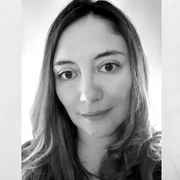

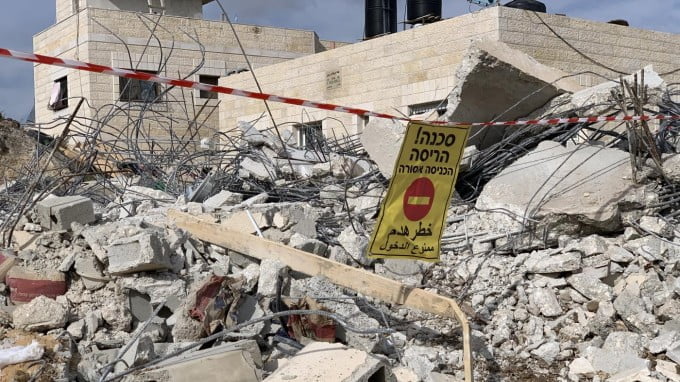
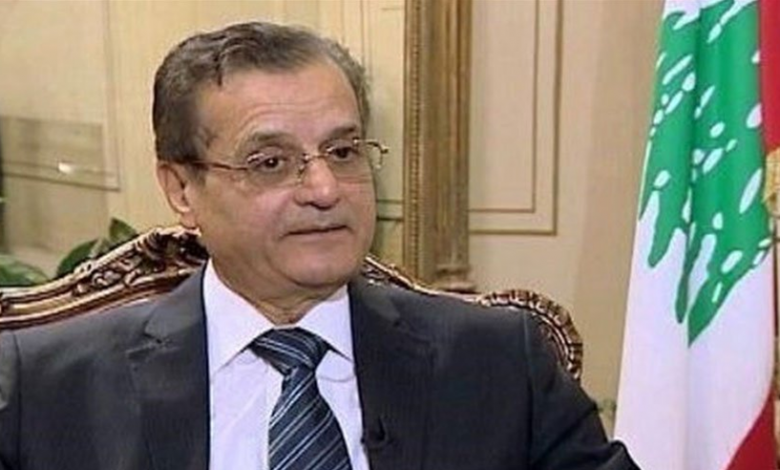

 At least 29 structures were demolished by Israeli forces in the occupied Palestinian Territories (including East Jerusalem) in the month of September, displacing 51 people- including 23 children- and affecting a further 79 people, including 54 children. In addition, two families from East Jerusalem self-demolished their homes. Inside Israel, in the Naqab desert, Israeli forces demolished the unrecognised Bedouin village Al-Arakib for the 133rd time, demolished another house in Hura, and another family self-demolished their home in Sa’wah. In central and Northern Israel two houses were demolished, displacing more then 15 people.
At least 29 structures were demolished by Israeli forces in the occupied Palestinian Territories (including East Jerusalem) in the month of September, displacing 51 people- including 23 children- and affecting a further 79 people, including 54 children. In addition, two families from East Jerusalem self-demolished their homes. Inside Israel, in the Naqab desert, Israeli forces demolished the unrecognised Bedouin village Al-Arakib for the 133rd time, demolished another house in Hura, and another family self-demolished their home in Sa’wah. In central and Northern Israel two houses were demolished, displacing more then 15 people.

















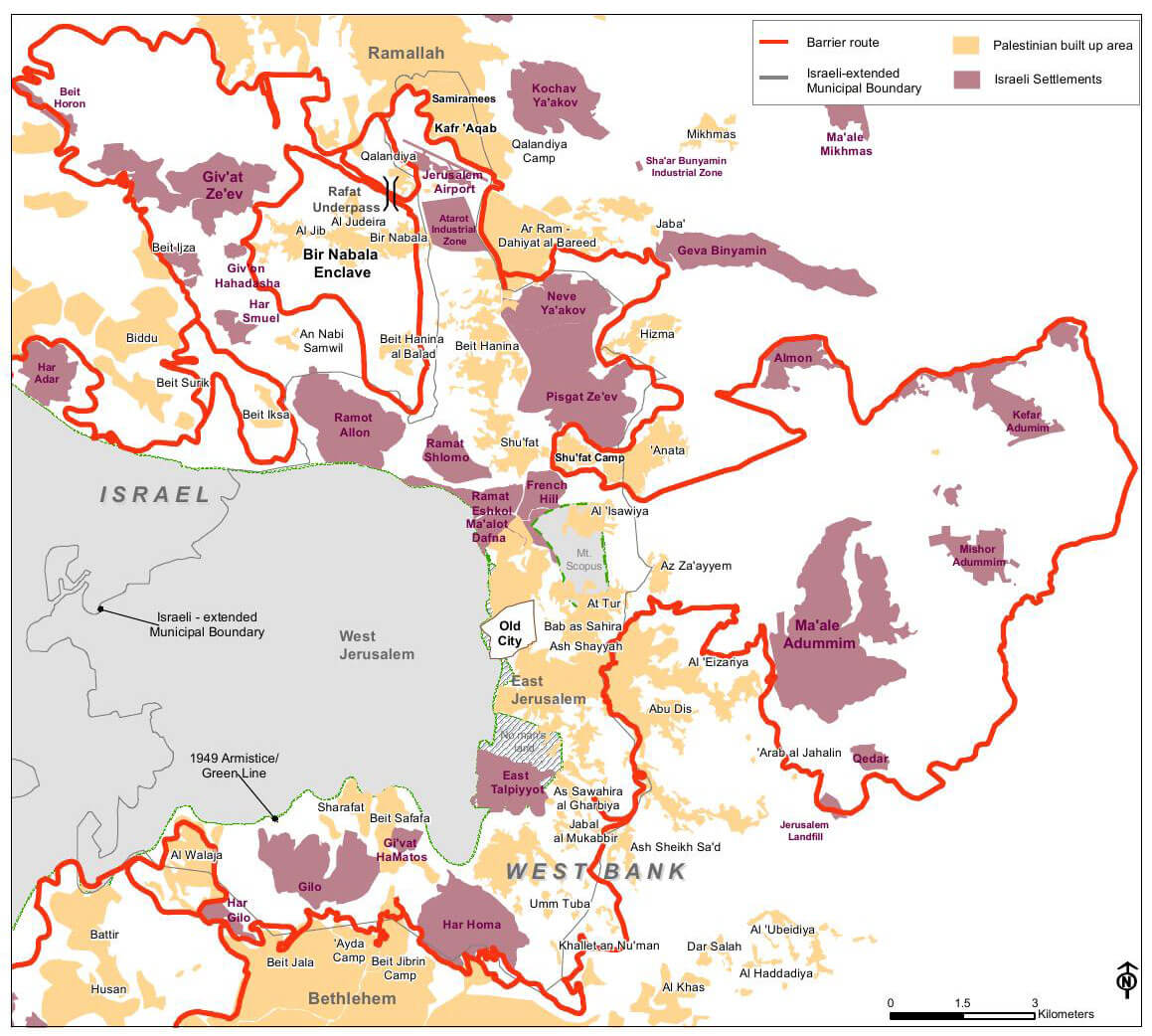 Map of East Jerusalem in 2007 shows the separation wall (in red) and the Israeli settlements in purple on areas of the occupied West Bank illegally annexed to Jerusalem. Source: United Nations Office for the Coordination of Humanitarian Affairs
Map of East Jerusalem in 2007 shows the separation wall (in red) and the Israeli settlements in purple on areas of the occupied West Bank illegally annexed to Jerusalem. Source: United Nations Office for the Coordination of Humanitarian Affairs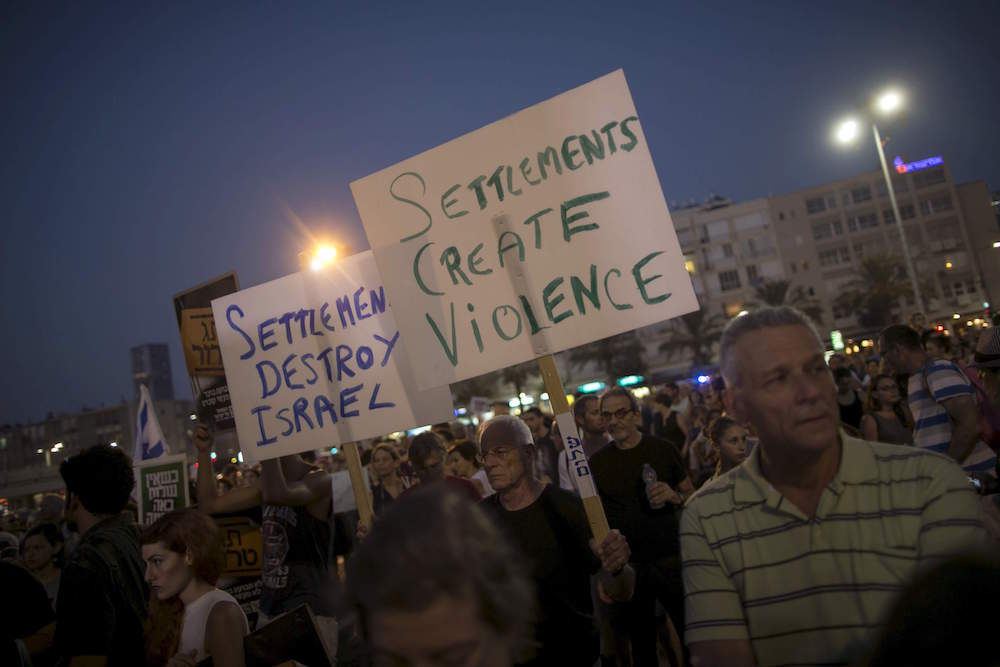


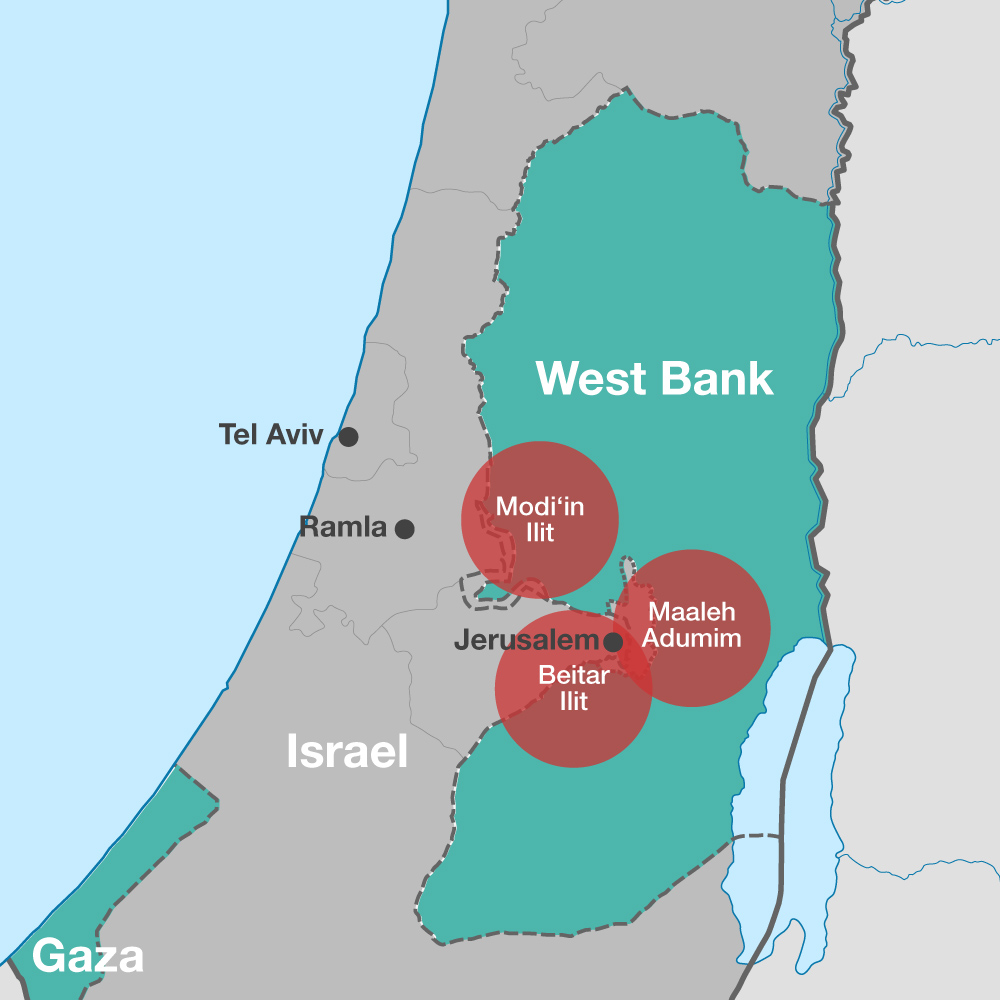
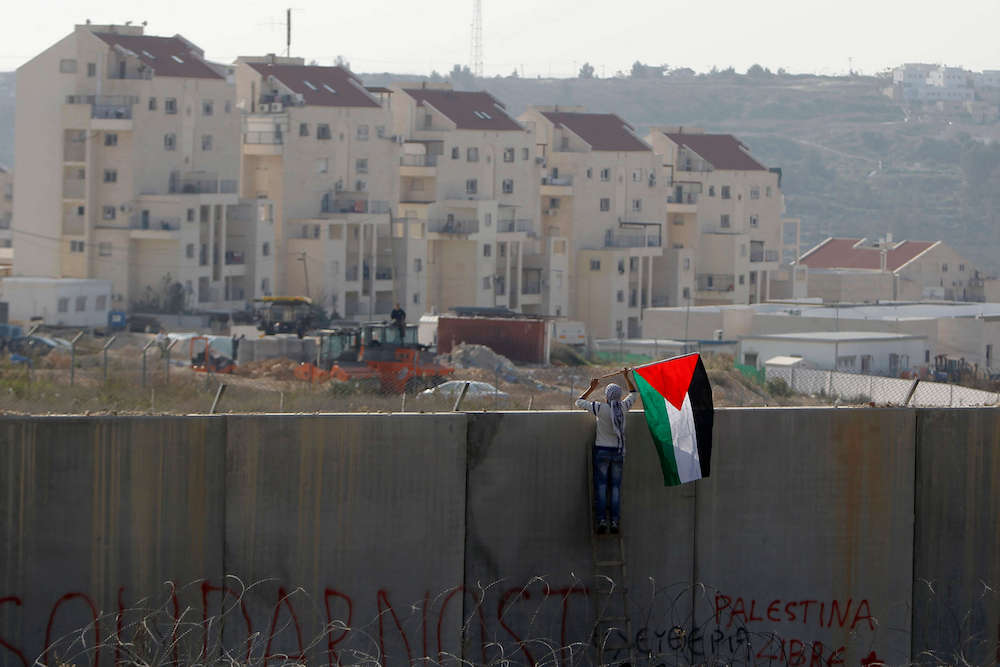 A boy places the Palestinian flag on the controversial Israeli separation wall, with Israeli settlements showing in the background. Source: Ammar Awad/Reuters
A boy places the Palestinian flag on the controversial Israeli separation wall, with Israeli settlements showing in the background. Source: Ammar Awad/Reuters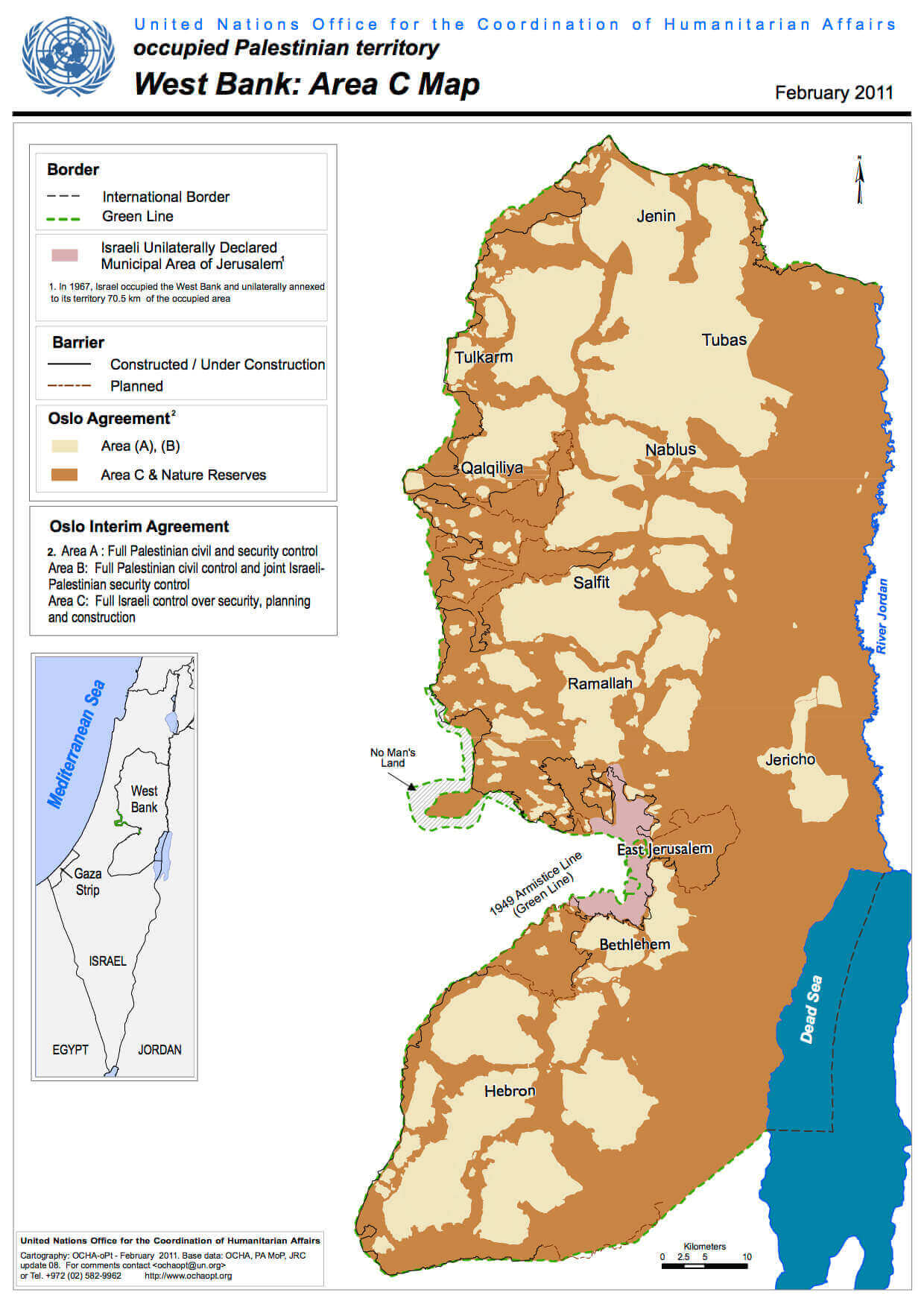
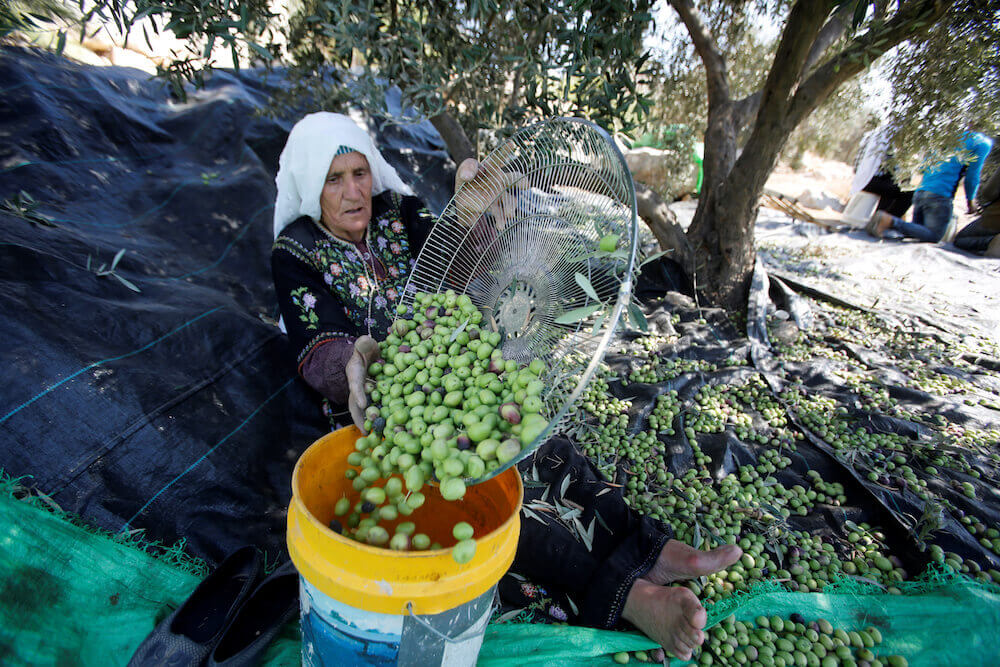 Close to half of the Biet Owwa village (pictured) lies in Area C and has been severely affected by the settlements, checkpoints and the separation wall surrounding it. Photo by Mussa Qawasma/ Reuters
Close to half of the Biet Owwa village (pictured) lies in Area C and has been severely affected by the settlements, checkpoints and the separation wall surrounding it. Photo by Mussa Qawasma/ Reuters Palestinians cross through the Israeli Qalandia military checkpoint near the occupied West Bank city of Ramallah. Photo by Ammar Awad/ Reuters
Palestinians cross through the Israeli Qalandia military checkpoint near the occupied West Bank city of Ramallah. Photo by Ammar Awad/ Reuters
